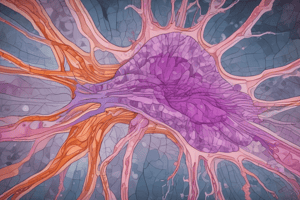Podcast
Questions and Answers
What is the typical thickness of paraffin sections cut for light microscopy?
What is the typical thickness of paraffin sections cut for light microscopy?
Which type of dye would most likely stain nucleic acids in tissue sections?
Which type of dye would most likely stain nucleic acids in tissue sections?
What color does hematoxylin produce when it stains DNA?
What color does hematoxylin produce when it stains DNA?
Which of the following components is stained by acidic dyes?
Which of the following components is stained by acidic dyes?
Signup and view all the answers
What is the purpose of staining tissue sections?
What is the purpose of staining tissue sections?
Signup and view all the answers
What type of linkages do dyes typically form with tissue macromolecules?
What type of linkages do dyes typically form with tissue macromolecules?
Signup and view all the answers
Which of the following is a common basic dye used in histology?
Which of the following is a common basic dye used in histology?
Signup and view all the answers
What do cationic components in tissues typically stain more readily with?
What do cationic components in tissues typically stain more readily with?
Signup and view all the answers
What is the primary purpose of eosin in H&E staining?
What is the primary purpose of eosin in H&E staining?
Signup and view all the answers
Which staining method specifically targets carbohydrate-rich tissue structures?
Which staining method specifically targets carbohydrate-rich tissue structures?
Signup and view all the answers
What effect does ribonuclease pretreatment have on tissue staining?
What effect does ribonuclease pretreatment have on tissue staining?
Signup and view all the answers
Which dye is specifically used to stain lipid-rich structures?
Which dye is specifically used to stain lipid-rich structures?
Signup and view all the answers
What is the role of metal impregnation in staining?
What is the role of metal impregnation in staining?
Signup and view all the answers
Which of the following factors can affect the duration of slide preparation?
Which of the following factors can affect the duration of slide preparation?
Signup and view all the answers
What can a Feulgen reaction specifically stain?
What can a Feulgen reaction specifically stain?
Signup and view all the answers
Which statement about slide preparation is true?
Which statement about slide preparation is true?
Signup and view all the answers
Study Notes
Histology I
- The presentation is about histology, specifically sectioning, medical application, staining, and related procedures.
- Histology focuses on the microscopic study of tissues.
- Sectioning involves trimming and placing a hardened tissue block with embedding medium into a microtome for sectioning.
- Paraffin sections are typically cut at thicknesses ranging between 3-10 µm for light microscopy, while electron microscopy needs sections less than 1 µm.
- Biopsies (tissue samples) are fixed in formalin for further microscopic analysis in a pathology lab.
- If quick results are needed before a procedure, rapid freezing in liquid nitrogen followed by sectioning with a cryostat is used.
- This preserves cell structures while making the tissue hard.
- Staining is crucial as most cells and extracellular material are colorless.
- Staining methods highlight tissue components, making them distinguishable.
- Basic dyes like toluidine blue, alcian blue, and methylene blue stain basophilic components (e.g., DNA, RNA, glycosaminoglycans).
- Hematoxylin acts as a basic dye, staining basophilic components.
- Acid dyes like eosin, orange G, and acid fuchsin stain acidophilic components (e.g., mitochondria, secretory granules, collagen).
- The combination of hematoxylin and eosin (H&E) is widely used for staining.
- Hematoxylin stains DNA, RNA and cartilage, producing a dark blue or purple color.
- Eosin stains cytoplasmic structures and collagen, producing a pink color.
Staining Procedures
- Trichrome stains, such as Masson's trichrome, offer finer distinctions among extracellular tissue components.
- The periodic acid-Schiff (PAS) reaction (utilizing hexose rings) stains carbohydrate-rich tissue structures.
- Areas well-stained by PAS are depicted in Figure 1-2b.
- DNA can be specifically stained using the Feulgen reaction, a modification of the PAS procedure.
Pretreatment of Tissue Sections
- Basophilic or PAS-positive materials can be further identified using enzyme digestion on tissue sections. This is achieved by using an enzyme that specifically digests a particular substrate.
- Pretreatment with ribonuclease notably reduces cytoplasmic basophilia, without significantly affecting the nuclei, this highlights the importance of RNA in cytoplasmic staining.
Studying Lipid-Rich Structures
- To analyze lipid-rich structures, processing steps that remove lipids are avoided.
- Treatment using heat and organic solvents is avoided if possible
- Staining with lipid-soluble dyes like Sudan black aids in visualizing these structures.
- This method is helpful during diagnosis of metabolic diseases involving intracellular accumulation of cholesterol, phospholipids, or glycolipids.
Metal Impregnation
- Metal impregnation, using silver salts, is a less common staining method.
- It helps visualize certain extracellular matrix (ECM) fibers and specific cellular components in nervous tissue.
Time Needed for Sample Preparation
- Slide preparation, from tissue fixation to microscopic observation, usually takes between 12 hours and 2½ days.
- The timing depends on the tissue size, embedding medium, and staining method used.
- The final step involves mounting a coverslip to the slide using a clear adhesive prior to microscopy.
Studying That Suits You
Use AI to generate personalized quizzes and flashcards to suit your learning preferences.
Related Documents
Description
This quiz covers the fundamentals of histology, focusing on techniques such as sectioning and staining of tissues. It explores medical applications, procedures involved in preparing samples, and the importance of staining in microscopy. Test your knowledge on these key histological practices essential for microscopic analysis.




